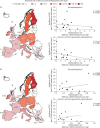Role of cephalosporins in the era of Clostridium difficile infection
- PMID: 27659735
- PMCID: PMC5161048
- DOI: 10.1093/jac/dkw385
Role of cephalosporins in the era of Clostridium difficile infection
Abstract
The incidence of Clostridium difficile infection (CDI) in Europe has increased markedly since 2000. Previous meta-analyses have suggested a strong association between cephalosporin use and CDI, and many national programmes on CDI control have focused on reducing cephalosporin usage. Despite reductions in cephalosporin use, however, rates of CDI have continued to rise. This review examines the potential association of CDI with cephalosporins, and considers other factors that influence CDI risk. EUCLID (the EUropean, multicentre, prospective biannual point prevalence study of CLostridium difficile Infection in hospitalized patients with Diarrhoea) reported an increase in the annual incidence of CDI from 6.6 to 7.3 cases per 10 000 patient bed-days from 2011-12 to 2012-13, respectively. While CDI incidence and cephalosporin usage varied widely across countries studied, there was no clear association between overall cephalosporin prescribing (or the use of any particular cephalosporin) and CDI incidence. Moreover, variations in the pharmacokinetic and pharmacodynamic properties of cephalosporins of the same generation make categorization by generation insufficient for predicting impact on gut microbiota. A multitude of additional factors can affect the risk of CDI. Antibiotic choice is an important consideration; however, CDI risk is associated with a range of antibiotic classes. Prescription of multiple antibiotics and a long duration of treatment are key risk factors for CDI, and risk also differs across patient populations. We propose that all of these are factors that should be taken into account when selecting an antibiotic, rather than focusing on the exclusion of individual drug classes.
© The Author 2016. Published by Oxford University Press on behalf of the British Society for Antimicrobial Chemotherapy.
Figures


Comment in
-
Comment on: Role of cephalosporins in the era of Clostridium difficile infection.J Antimicrob Chemother. 2018 Feb 1;73(2):550-551. doi: 10.1093/jac/dkx377. J Antimicrob Chemother. 2018. PMID: 29092040 No abstract available.
References
-
- Kelly CP, LaMont JT. Clostridium difficile—more difficult than ever. N Engl J Med 2008; 359: 1932–40. - PubMed
-
- PHE. Clostridium difficile: Guidance, Data and Analysis. Annual Counts and Rates of Clostridium difficile (C. difficile) Infections by Acute Trust and Clinical Commissioning Group (CCG) in Patients Aged 2 years and Over. https://www.gov.uk/government/statistics/clostridium-difficile-infection....
-
- Evans CT, Safdar N. Current trends in the epidemiology and outcomes of Clostridium difficile infection. Clin Infect Dis 2015; 60 Suppl 2: S66–71. - PubMed
-
- Khanna S, Pardi DS. The growing incidence and severity of Clostridium difficile infection in inpatient and outpatient settings. Expert Rev Gastroenterol Hepatol 2010; 4: 409–16. - PubMed
Publication types
MeSH terms
Substances
LinkOut - more resources
Full Text Sources
Other Literature Sources
Medical

